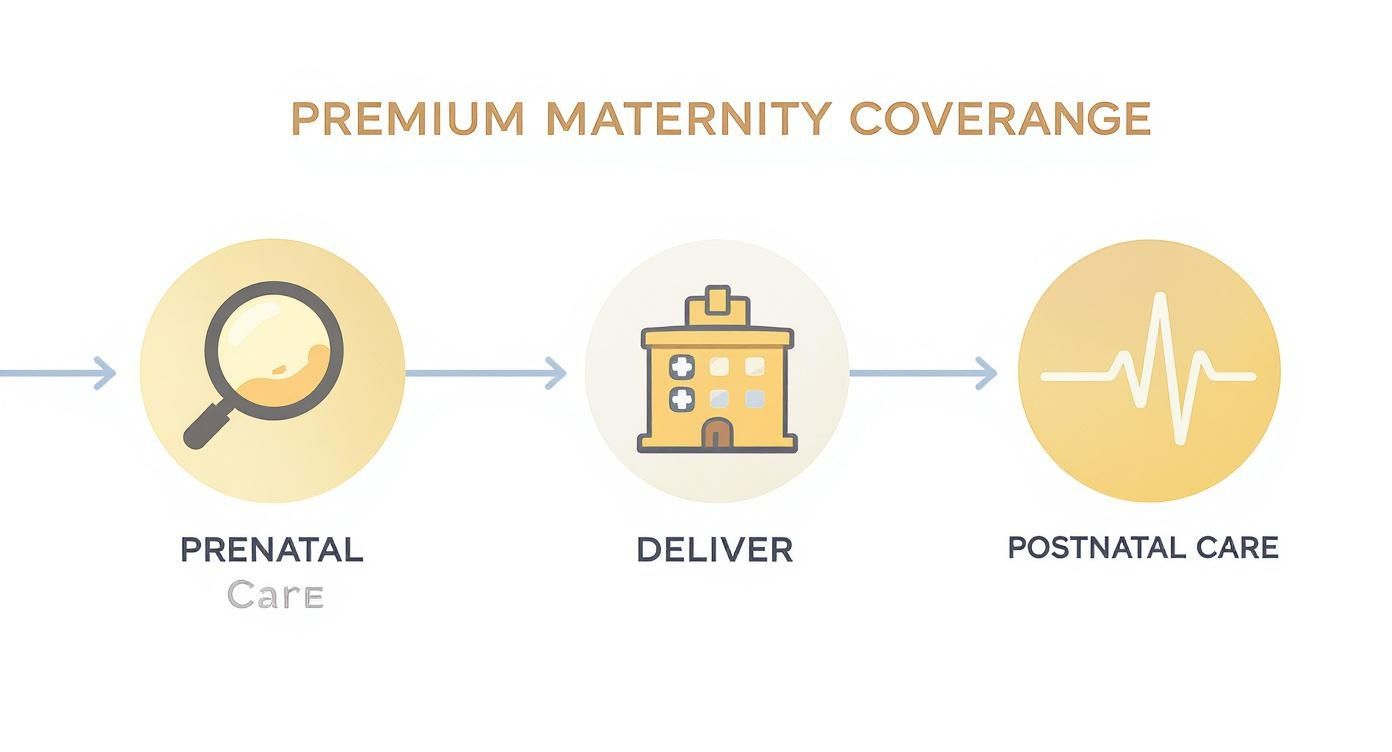Planning a family is a significant, exciting milestone in your life. This journey requires astute financial and personal planning. For discerning high-net-worth individuals, selecting the right private insurance with maternity coverage is not a mere formality—it is a cornerstone of your family's well-being. This strategic choice secures access to premier medical care and, just as importantly, provides invaluable peace of mind.
Securing Your Family's Future with Maternity Insurance

Starting a family is an investment in your legacy. You would not leave your financial portfolio to chance; your approach to maternity healthcare should be equally diligent. A premium insurance policy is not simply about covering invoices; it is about guaranteeing choice, comfort, and access to the best care available, wherever you are in the world.
This guide moves beyond generic advice to provide specific, actionable insights tailored for professionals who expect the highest standards. We will dissect the essentials of first-class maternity plans, from comprehensive prenatal and postnatal care to the non-negotiable requirement of global coverage for an international lifestyle. Mastering these details is the first step toward a confident and well-informed decision.
The Strategic Value of Early Planning
The single most important principle of private maternity insurance is that timing is everything.
Nearly all high-quality policies enforce a mandatory waiting period before pregnancy and childbirth benefits are activated. This period, which typically ranges from 10 to 24 months, is an industry standard that protects the insurer's risk pool. It requires you to plan substantially in advance.
You must secure your policy long before conception to ensure you are fully covered when the time comes. Consider it analogous to reserving a five-star resort for a milestone anniversary; you do not wait until the week before and hope for availability. Forward planning eliminates the risk of substantial out-of-pocket costs and allows you to focus on your well-being, not last-minute financial stress.
A well-chosen maternity insurance plan is more than a safety net. It is an active tool for managing your family's health and financial security, enabling you to focus entirely on the joy of the experience.
What to Expect from This Guide
In this guide, we provide the clarity required to navigate the jargon and complexity of maternity insurance. You will learn to evaluate policies with an expert eye, understanding everything from coverage limits to the importance of an extensive network of trusted physicians and hospitals.
Here's what we'll cover:
- Comprehensive Coverage Details: A breakdown of what constitutes premium prenatal, delivery, and postnatal care.
- Navigating Timelines: Strategic advice on managing waiting periods to align perfectly with your family planning objectives.
- Financial Transparency: A clear examination of the premiums, deductibles, and other costs associated with elite medical care.
- Global Healthcare Access: How to ensure your coverage accommodates your international career and lifestyle.
Consider this your roadmap to making a sound investment in your family’s health and future.
What Premium Maternity Insurance Actually Covers
It must be understood that not all maternity insurance is created equal. A standard policy will likely cover basic necessities, but a premium plan offers a fundamentally different experience. It is structured around choice, comfort, and access to superior medical care when it is most critical. Discerning what separates a truly superior policy from a merely adequate one is the key to a wise investment in your family's future.
The distinction is akin to selecting a vehicle. A standard sedan provides transportation. A luxury vehicle, however, is engineered to a higher standard, with superior safety features, enhanced performance, and a level of comfort that transforms the entire experience. Premium private insurance with maternity coverage operates on the same principle; it is designed for a higher echelon of care and provides complete peace of mind throughout the entire journey.
This is not a niche concern. The global market for this level of care is substantial. According to a 2023 report by Coherent Market Insights, the global maternity care market was valued at USD 19.3 billion in 2023 and is projected to grow significantly. This trend is fueled by a growing understanding that specialized care during pregnancy is a necessity, not a luxury.
The Three Pillars of Premium Coverage
A genuinely exceptional maternity plan is built upon three pillars of care. Each offers a depth of service not found in a standard policy, designed to support you from the first prenatal consultation until well after you have brought your newborn home.
- Comprehensive Prenatal Care: This extends far beyond routine appointments. It encompasses access to top-tier obstetricians and specialists, advanced genetic screenings, and detailed ultrasounds. You should expect full coverage for any consultation required to address your specific health profile, ensuring a proactive and deeply personalized approach from day one.
- Flexible and Secure Delivery Options: A premium policy places you in control. It covers delivery in premier private hospitals and allows you to select your preferred physician and anaesthesiologist. Critically, it provides robust coverage for both elective and emergency Caesarean sections and includes very high financial limits for any complications, shielding you from unexpected, six-figure invoices.
- Robust Postnatal and Newborn Support: The support must not end at delivery. Superior plans extend coverage to lactation consultants, home visits from nurses, and maternal mental health support. Newborn care is another critical feature, often covering wellness checks, initial vaccinations, and—a vital safety net—care for congenital conditions discovered at birth.
Understanding Your Access to Top-Tier Providers
A significant differentiator of a premium plan is its provider network. This can be thought of as an exclusive directory of the world's leading physicians, clinics, and hospitals. A top-tier policy is your access pass, allowing you to choose from a curated list of elite professionals without geographical constraints.
The real value of a premium maternity plan lies not just in what it pays for, but in the freedom it affords you. It's the ability to choose the best doctor, the best hospital, and the best course of treatment without compromise.
This means if you are an expatriate residing in Singapore, you can receive the same caliber of care you would expect in London or New York. For a deeper understanding of how these networks operate, our guide on the benefits of international private medical insurance is an excellent resource. This flexibility is essential for globally mobile professionals whose healthcare choices cannot be dictated by their current location. Ultimately, a premium plan is defined by the quality and breadth of choices it provides.
How to Navigate Waiting Periods and Timelines
When securing premier private insurance with maternity coverage, timing is not merely important—it is the paramount factor. This is the single most critical, non-negotiable aspect of the process.
Nearly every high-quality policy includes a mandatory waiting period before the maternity benefits become active. This is not a minor detail in the fine print; it is the central pillar around which you must construct your family planning timeline.
Typically, this waiting period ranges from 10 to 24 months from your policy's start date. Insurers implement this for a clear reason: to ensure the policy is a forward-thinking investment in your family's health, not a reactive purchase made immediately following conception. Adhering to this timeline is the key to avoiding substantial, and entirely preventable, out-of-pocket costs.
The Logic Behind Waiting Periods
A maternity insurance policy should be viewed as a long-term investment in your growing family. The waiting period is analogous to a vesting period in finance—it ensures a genuine commitment from both you and the insurer.
It protects the insurer's risk pool from an influx of immediate, high-cost claims, which helps maintain stable and predictable premiums for all policyholders. This system ensures the plan remains financially sound enough to provide the extensive, high-quality benefits for which you are paying.
Therefore, the waiting period should not be seen as an obstacle. Instead, it is a fundamental rule of engagement that requires strategic planning on your part.
This timeline provides a visual representation of how a well-planned policy aligns perfectly with the key stages of maternity care, from the first prenatal check-ups through to postnatal support.

As illustrated, having your coverage active before any prenatal care begins is crucial. This guarantees that every step of your journey is fully supported.
Mapping Your Ideal Timeline: A Practical Example
Misinterpreting the waiting period is the most direct path to a significant coverage gap. Let us walk through a clear, practical scenario to demonstrate how to time your policy purchase perfectly.
The core principle is simple but absolute: the policy's waiting period must be completed before conception occurs. Any other approach invites financial risk.
Suppose you and your partner are planning to start a family next year. You have identified an excellent policy with a 12-month maternity waiting period. Here is how to plan accordingly:
- Step 1: Purchase the Policy. You secure your insurance plan on January 1, 2025.
- Step 2: Serve the Waiting Period. The 12-month clock begins immediately and concludes on December 31, 2025. Your maternity benefits are dormant during this time.
- Step 3: Plan for Conception. You can begin trying to conceive from January 1, 2026, onward, with complete peace of mind.
- Step 4: Full Coverage Activation. If conception occurs in January 2026, every subsequent prenatal appointment, scan, and the delivery itself will be fully covered under your policy's terms.
By simply working backward from your desired start date, you ensure a seamless transition into full coverage. This foresight completely removes financial stress from the equation, allowing you to focus on what truly matters—your family's well-being. This strategic approach transforms the waiting period from a potential pitfall into a simple planning milestone.
A Transparent Look at Maternity Healthcare Costs
For those who manage their finances with precision, understanding the full cost of childbirth is non-negotiable. The monthly premium is only the beginning. To budget for your growing family without unforeseen expenses, you must look beyond this figure to gain a clear picture of the true cost of private insurance with maternity coverage.
This involves understanding how your premium is calculated and, just as crucially, what other costs may arise. Your premium is primarily shaped by the level of coverage selected, your country of residence, and your desired hospital network. A plan that provides access to a worldwide network of elite medical facilities will naturally command a higher premium than one limited to a single country.
Deconstructing Your Total Financial Commitment
Your total investment is a combination of your insurance premium and any out-of-pocket expenses. The premium is your fixed cost—the predictable, recurring fee for access to top-tier care. The variable costs are where careful planning is rewarded.
These variables typically consist of three main components:
- Deductibles: The amount you pay for medical services before your insurance begins to contribute. For instance, if your policy has a $1,000 deductible, you are responsible for the first $1,000 of covered medical bills.
- Copayments: A fixed fee for a specific service, such as a consultation or prescription. This might be a $50 fee for each prenatal visit with your specialist.
- Coinsurance: Once your deductible is met, you and your insurer share the remaining cost. If your plan has 10% coinsurance, you pay 10% of the subsequent bill, and the insurance company covers the other 90%.
Mastering these terms is the key to financial clarity. We delve deeper into this subject in our guide on understanding excesses and deductibles in insurance policies. This knowledge empowers you to forecast your total financial exposure with accuracy.
Real-World Costs and Your Share
The costs of pregnancy and childbirth can be substantial. In the United States, for example, a 2022 analysis by the Peterson-KFF Health System Tracker found that the average cost for childbirth hospitalization alone was $13,811 for vaginal delivery and $26,280 for a C-section for those with large employer-sponsored plans. While a premium plan covers the majority, you must understand your share.
Financial transparency in your maternity plan is not a bonus; it is a requirement. A clear view of all potential costs allows you to focus on the health of your family, secure in the knowledge that there will be no financial surprises.
It is also prudent to account for potential complications or common pregnancy-related health issues like hemorrhoids, which can introduce unexpected costs. A premium plan is designed to absorb these financial shocks, but you must still understand your policy's structure.
To make this more concrete, the following table illustrates how costs might break down under a premium plan, showing what you might expect to pay for various services and how much your insurance would typically cover.
Sample Cost Breakdown for Premium Maternity Care
| Service Category | Average Total Cost | Typical Insurance Coverage (90%) | Estimated Out-of-Pocket Expense |
|---|---|---|---|
| Prenatal Care & Scans | $4,000 | $3,600 | $400 |
| Standard Delivery & Hospital Stay | $15,000 | $13,500 | $1,500 |
| Anesthesiologist Fees | $2,500 | $2,250 | $250 |
| Postnatal & Newborn Care | $3,000 | $2,700 | $300 |
| Total | $24,500 | $22,050 | $2,450 |
This example assumes your deductible has been met. As you can see, a robust insurance plan absorbs the vast majority of the costs, leaving you with a much more manageable portion.
A Practical Cost Scenario
Let us walk through a hypothetical situation. Imagine you have a premium plan with a $500 deductible and 10% coinsurance.
The total bill for your hospital stay and delivery is $15,000.
- Meet the Deductible: First, you pay your $500 deductible.
- Calculate Coinsurance: The remaining bill is $14,500. Your 10% share is $1,450.
- Insurer's Share: Your insurance company covers the remaining 90%, which is $13,050.
- Your Total Out-of-Pocket Cost: For this event, your total responsibility is $1,950 (the $500 deductible + $1,450 in coinsurance).
This example demonstrates how dramatically a strong insurance plan can reduce your direct financial burden. By demystifying these costs, you can confidently select a policy that aligns with both your healthcare standards and your financial strategy.
Ensuring Global Coverage for Your Lifestyle

For a globally mobile professional, life is not confined to one country, and neither is your career. Your healthcare should reflect this reality.
Standard health insurance is often geographically restricted, rendering it ineffective the moment you cross a border. This is where a true international private insurance with maternity coverage plan becomes an absolute necessity.
An international plan is designed to move with you, providing seamless, high-quality care whether you are at your home base, on a long-term assignment in Singapore, or traveling for business in London. It ensures a consistent, predictable standard of care, regardless of the complexities of the local healthcare system. This freedom is the essence of a premium global policy.
Defining Your Area of Coverage
The most critical element of any global plan is its area of coverage. This defines the geographical boundaries within which your policy is valid. It is essential to define this correctly, ensuring it perfectly aligns with your work, travel, and residency plans.
A common oversight is to assume "global" means universal coverage. It often does not. Many policies exclude notoriously high-cost countries, such as the United States, unless you specifically opt for a "worldwide including USA" plan. A mistake in this detail can leave you dangerously exposed financially.
True global coverage is about more than just payment for care abroad. It's about having the logistical and financial peace of mind to access elite medical facilities anywhere in the world as if you were in your home city.
Imagine you are an executive based in Hong Kong. You travel to Europe frequently for work and are considering delivering your baby in Switzerland for its renowned medical care. A well-designed global maternity plan would provide access to premier hospitals and specialists in all three locations without any degradation in your level of benefits.
The Power of Worldwide Provider Networks
A key advantage of a top-tier international plan is its direct access to a worldwide network of elite hospitals and clinics. This is not merely a list of approved physicians; it is a curated ecosystem of premier medical facilities with which your insurer has a direct billing relationship.
The benefit to you is significant. You can receive care at a top international hospital without paying a substantial bill upfront and subsequently seeking reimbursement. The hospital bills your insurer directly, removing a considerable layer of financial and administrative stress at a time when you need it least.
- Seamless Access: Schedule appointments and receive treatment at leading international facilities without logistical hurdles.
- Direct Billing: Eliminates the need for large out-of-pocket payments, which is invaluable during a critical period.
- Medical Evacuation: If you require specialized care that is not available locally, a robust plan will cover the costs of medically evacuating you to the nearest center of excellence.
Understanding the strength of this network is crucial. For a deeper analysis of how these systems function, our guide to international medical networks provides a detailed breakdown. This network is your guarantee of quality and convenience, no matter where your life takes you.
How to Choose the Right Maternity Insurance Plan
Selecting the right private insurance for your maternity journey is a serious, strategic decision. Think of it as laying the financial and healthcare foundation for your growing family. A correct choice allows you to focus on the experience itself. An incorrect one could lead to unexpected bills and coverage gaps at the worst possible time.
The real work begins when you move beyond marketing materials and into the policy's fine print. You must investigate the specific limits, exclusions, and conditions that truly define the scope of coverage. Your objective is not just to find a plan, but to find the one that instills complete confidence.
A Checklist for Informed Decision-Making
When engaging with potential insurers, you must be in command of the conversation. Arrive with a precise list of questions designed to ensure their policy aligns perfectly with your expectations for world-class care.
Key points to clarify:
- Complications Coverage: What are the exact financial limits for complications for both mother and baby? Do not accept vague assurances.
- Newborn Care Provisions: Is the baby covered from the moment of birth? What is the scope of that coverage for congenital conditions or a potential NICU stay?
- Fertility and Assisted Reproduction: Are treatments like IVF included? It is also wise to monitor legislative efforts requiring fertility treatment insurance coverage, as these can dramatically alter available benefits.
- Claims Process: What does the claims process entail, particularly for care received abroad? Is direct billing a standard feature or a rare exception?
The Strategic Advantage of a Specialized Advisor
For busy professionals, time is your most valuable asset. Attempting to navigate the complexities of international insurance independently is an inefficient use of that time. Engaging a specialized insurance advisor is a powerful strategic move. A first-rate advisor is not merely a salesperson—they are your advocate.
These experts possess deep market knowledge and established relationships with insurers, often providing access to plans not available on public websites. They can benchmark different policies against your unique needs, from your preferred hospital network to your family's travel patterns, ensuring a perfect fit. What would be a complex project for you becomes an efficient, clear process for them.
The right policy is not merely an expense but a crucial investment in your family's health and security, delivering unparalleled peace of mind during this important chapter of your life.
By focusing on these critical areas—vetting the policy details yourself and leveraging expert guidance—you can make a choice with genuine confidence. This methodical approach ensures your maternity insurance is more than a document; it is a solid foundation for your family’s future, providing the ultimate luxury: the freedom to focus entirely on welcoming your new child.
Frequently Asked Questions
When examining the fine print of private insurance with maternity coverage, many practical questions arise. Achieving total clarity on key details is essential for a confident decision. Here are direct answers to the most common inquiries we receive.
Does Private Insurance Cover Fertility Treatments?
This is a critical question, and the answer varies. Historically, treatments like IVF were almost universally excluded from standard plans. This is beginning to change, particularly with top-tier international policies, which are starting to offer some level of fertility coverage, typically as an optional rider.
However, you must exercise diligence. This coverage often comes with its own set of rules, such as specific sub-limits, unique waiting periods, or eligibility requirements. It is imperative to inquire about this directly when comparing your options.
Are High-Risk Pregnancies Covered?
Yes, and this is a primary reason to invest in a premium maternity plan. These policies are structured to be a robust financial safety net, designed specifically to manage the costs of specialist consultations, advanced testing, and extended hospital stays that can accompany a high-risk pregnancy or complications.
The main caveat concerns pre-existing conditions. If you have a known health issue that could complicate a pregnancy, it may be excluded or require a specific underwriting decision. Full transparency regarding your medical history during the application process is non-negotiable.
The true measure of a policy's quality is whether the financial limits for complications are high enough to provide genuine peace of mind. It exists to protect you from unexpected costs that can be financially devastating.
What Is a Moratorium in Maternity Insurance?
A moratorium is a "wait and see" approach to underwriting. Instead of requiring a lengthy medical questionnaire upfront, the insurer will not cover any pre-existing conditions for which you have received treatment or advice in the preceding five years.
For maternity, this could mean that a pre-existing condition that might complicate a pregnancy would not be covered for a set period, typically 24 months. If you remain symptom-free and require no treatment for that specific condition during this period, it may then become eligible for coverage. It is a faster way to secure a policy but demands a thorough awareness of your own medical history.
Is Postnatal Care for Mother and Baby Included?
Absolutely. A high-quality maternity plan would be incomplete without it. Comprehensive postnatal care is a cornerstone of these policies and extends well beyond the day of delivery.
For the mother, this typically includes:
- Follow-up consultations with your obstetrician.
- Support for recovery, particularly following a C-section.
- Access to services such as lactation consultants.
For your newborn, the plan should provide:
- Coverage from birth for wellness check-ups and standard vaccinations.
- Crucially, coverage for congenital conditions and any necessary care in a Neonatal Intensive Care Unit (NICU).
This dual approach ensures both mother and child receive continuous, top-tier medical support during the vital first weeks and months.
Navigating these complexities alone can be overwhelming. At Riviera Expat, we specialize in securing world-class international health insurance for discerning professionals. We ensure your policy is a perfect match for your family's future. Contact us for a complimentary consultation today.

